Pages 417-422
A History of the County of Hampshire: Volume 4. Originally published by Victoria County History, London, 1911.
This free content was digitised by double rekeying. All rights reserved.
In this section
BARTON STACEY
Bertune (xi cent.); Berton Sacy (xiii cent.); Bertone Stacy, Barton Sacy (xiv cent.).
Barton Stacey parish includes the tithings of Barton Stacey, Bransbury, Drayton, and Newton Stacey, and contains 5,026 acres of land, of which 407¼ acres are arable land and 213 woodland (fn. 1); it is bounded on the eastern side by a long line of trees known as Barton Stacey Belt.
The village of Barton Stacey lies in the valley of the Test, and is intersected by two roads, which run south from Longparish and east from Chilbolton. The church of All Saints stands on high ground north of the cross-roads and on its churchyard wall are the remains of a cross made of Lower Oolite limestone, which is not found in Hampshire but in Gloucestershire near the abbey of Lanthony (Lanthonia Secunda), to which the rectory of Barton Stacey belonged from early in the 13th century until 1541. The house that was once the farm-house of Church Farm, the property of Mr. R. K. Hodgson, has signs of considerable antiquity in one wing, which is built of large timbers with a heavy timbered roof. It was probably a single-storied hall at first, but has now been divided up, and its windows and other features are modern.
West of the village and close to that of Newton Stacey is a grass-grown track, said to be a disused part of the Roman road from Winchester to Cirencester, which runs northwards past Bransbury Common. This road divides between Barton Stacey and Newton Stacey, and close to it are six tumuli, one of which is long. (fn. 2) East of the common is the village of Bransbury with a watermill, possibly on the site of the mill mentioned in Domesday Book. The country is low-lying and liable to floods; between Bransbury and Drayton the River Test and Micheldever Brook form the boundaries to a long peninsula, across the landward end of which is the entrenchment known as Andyke. (fn. 3) Drayton Park lies to the north.
The soil is loam, the subsoil chalk. The chief crops are wheat, barley, oats and turnips.
Among place-names in extant local records are the following:—Ladycroft, Hamelescroft, Sheppark, Ronseldespathe, Brokholee, Sinocacre, Syngyngland, Cocum, Bertonesdowne, Coudowne and Westmere (xv cent.). (fn. 4)
Manors
The manor of BARTON STACEY, according to the Domesday Survey, formed part of the ancient demesne of the Crown and provided half a day's farm of King Edward's farm. (fn. 5) It seems to have belonged to the Crown till 1199, when it was granted, probably with NEWTON, (fn. 6) which in 1086 had belonged to William son of Manne, (fn. 7) to Rogo de Sacy or Stacey by King John. From this date Barton and Newton followed the same descent, the estate being at first called the manors of Barton and Newton, but subsequently Barton Stacey only. Rogo was succeeded by his son Aimery, (fn. 8) who in 1215 obtained from King John a charter granting him a weekly market every Saturday at Barton Stacey. (fn. 9) Aimery forfeited his land in 1219, (fn. 10) but was restored before 1226, in which year a lawsuit between him and his men of Barton and Newton was postponed ' that the king might try to make peace between them.' (fn. 11) He obtained in 1231 a confirmation of the grant of 1199, (fn. 12) and in 1241 a confirmation of the charter of 1215 with an additional grant of a yearly fair on the vigil and feast of St. Margaret. (fn. 13) On his death, c. 1253, the manor was divided between his two daughters, Isabel, who was twice married, first to Warin de Bassingbourn and secondly to Ralph Gascelyn, and Agnes, afterwards the wife of Peter Coudray. (fn. 14) Warin was given the custody of the land of Agnes 'while she is under age and lives with her mother,' on condition that he provided her with sufficient food and clothing and paid £15 yearly to the king. (fn. 15) A final settlement of the division of the estate between the sisters was made in 1269. (fn. 16)
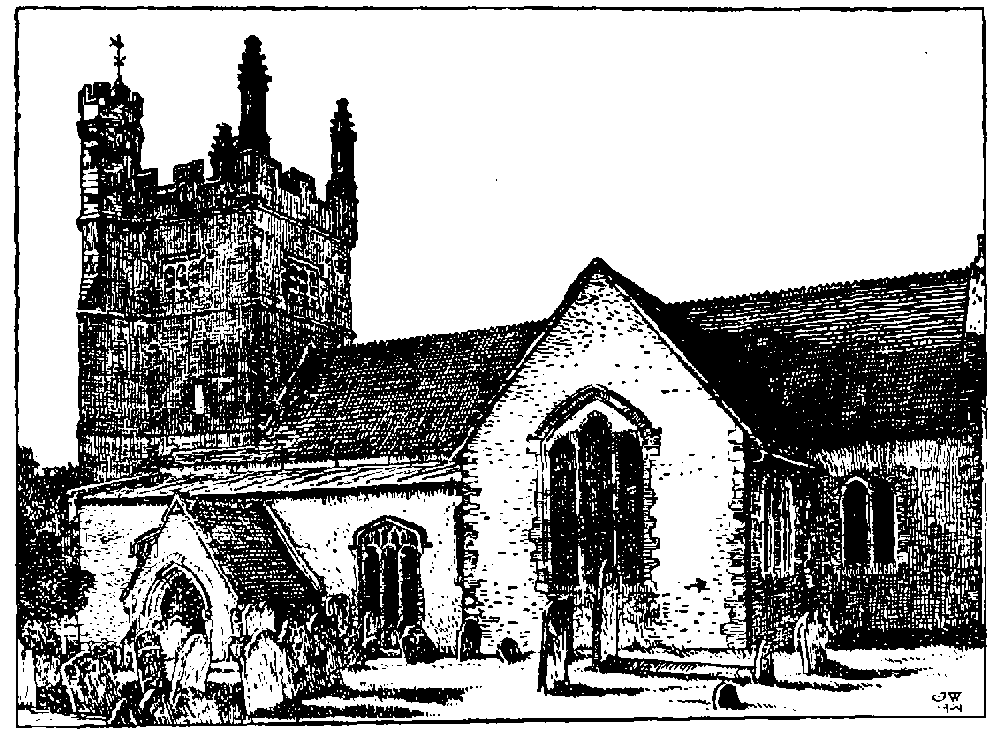
Barton Stacey Church from the South
Before 1313 Agnes was succeeded by her son Thomas de Coudray, (fn. 17) who about 1324 settled his moiety of the manor of Barton Stacey on himself for life with remainder to his kinsman Fulk de Coudray and Joan his wife. (fn. 18) Thomas was afterwards knighted and died in 1348, (fn. 19) when the manor passed in accordance with the settlement to Fulk and Joan, who in 1370 granted it to Elizabeth de Coudray their kinswoman. (fn. 20) It was perhaps by her marriage that the estate passed to the Popham family, for in 1397 Philip Popham is said to have held it 'of the inheritance of his late wife Elizabeth.' (fn. 21) Their son and heir Philip died in 1400, (fn. 22) and upon the death of his infant son in the following year (fn. 23) the inheritance was divided between his daughters Margaret and Maud, (fn. 24) but it was re-united in 1420 when Maud, who had married Peter Coudray, died, leaving her ' moiety of the moiety of Barton Stacey manor ' to her sister, then the wife of John Coudray. (fn. 25) Margaret was thrice married, but had children only by her second husband, Thomas Wayte. She died before her third husband, Robert Longe, who held the estate for life and was succeeded in 1447 by her son Thomas Wayte. (fn. 26) This Thomas died in the following year, and the estate then passed to the Longe family as the inheritance of his sister Margaret the wife of John Longe, (fn. 27) the younger son of Robert Longe by his first wife Alice. The Longes continued in possession until 1576, (fn. 28) when Robert, the great-grandson of John and Margaret, sold the manor to John Henton. (fn. 29) In the following year it was bought by Thomas Salmon, (fn. 30) the owner of Ringbournes, the moiety of the original manor of Barton which had belonged to Isabel daughter and co-heiress of Aimery de Sacy.

Coudray. Sable ten billets or.
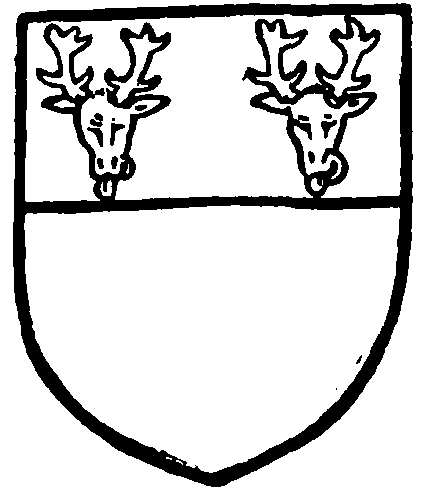
Popham. Argent a chief gules with two harts' heads caboshed or therein.
The history of that moiety had been as follows:—Isabel had alienated her share of the manor in 1293 to John de Berewick, (fn. 31) who was succeeded in 1312 by his infant kinsman, Roger Husee. (fn. 32) Roger was born on 1 August 1307 (fn. 33) and was declared to be of full age in July 1327. (fn. 34) The custody of his possessions in Barton Stacey during his minority was sold for £100 to the elder Hugh le Despenser, (fn. 35) in whose keeping the manor seems to have suffered, for in 1322 he complained that Roger Mortimer and others had 'entered with force into Berton Sacy and carried away all goods and chattels moveable and immoveable, to wit . . . with other necessaries they took the chessboard, made partly of nut-wood and partly of ginger-root with the set of ivory and ebony . . . they broke the fish ponds and carried away the fish, without leaving anything, and tore down and carried away all the doors, locks, bars, windows, and lead from the house . . . they destroyed the hedges and sold and carried away all the wood for felling.' (fn. 36) In 1338 Roger Husee took part in the Scottish expedition, and the next year, 'with all the strength he could raise, assisted John de Warenne, Earl of Surrey, in defending the sea-coasts. Moreover, he was in the wars of France, in which he merited so well that he was summoned to Parliament' as a baron in 1349. (fn. 37) He died in September 1361, (fn. 38) leaving Barton Stacey to his brother John, (fn. 39) who in 1370 granted an annuity of £40 from the manor to William of Wykeham, Bishop of Winchester. (fn. 40) This John was succeeded at his death in the same year by his son and namesake, (fn. 41) who alienated to Hugh le Cran in 1373 £6 rent from the estate, (fn. 42) and in the next year his whole interest in Barton Stacey. (fn. 43) In October 1379 Stephen Haym and John Byturle, acting as the agents of Hugh le Cran, sold the moiety of Barton Stacey to William Ringbourne. (fn. 44) A rent of £10 yearly was reserved to Stephen Haym, (fn. 45) and was afterwards granted by him to Nicholas Carew and Mercy his wife, (fn. 46) who alienated it to Robert Longe and Margaret. (fn. 47)

Longe. Sable crusilly and a lion argent.
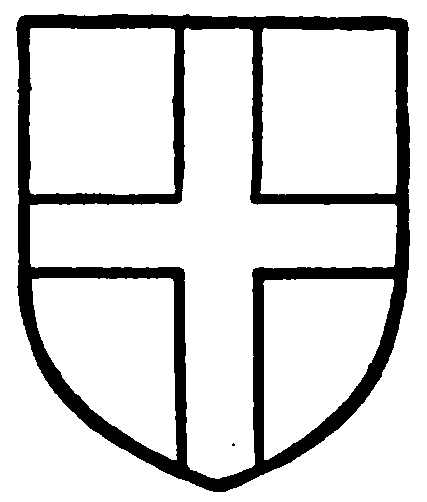
Husee. Or a cross vert.
William Ringbourne was sheriff of the county of Southampton in 1381 (fn. 48); a commission of array ' to resist invasion in case of war after the expiration of the present truce' was sent to him in 1392, (fn. 49) and he received a like commission in 1399, (fn. 50) in which year he was also made a commissioner of the peace. (fn. 51) He died in 1400, (fn. 52) leaving as his heir his son William, who was sheriff in 1421. (fn. 53) The inquisition taken on the death of this second William in 1423 (fn. 54) gives the extent of the estate; there were 200 acres of arable land, 20 acres of meadow and 400 acres of pasture, which were held by military service of half a knight's fee, and William also held four messuages and 5 virgates of land in Barton Stacey from William Wayte (fn. 55) and Margaret his wife. Further details are given in the second part of the inquisition which concerns the dowry claimed by Agnes, now the wife of John Holcombe, formerly the wife of the said William Ringbourne—'one chamber called the "Presteschamber" and one stable in the eastern part of the said chamber and one "yatelyms" with two chambers . . . a third part of the garden, namely from the furnace outside the garden as far as the common field' with one-third of the profits of the manor, over 500 acres of land and rents from numerous tenants. The estate belonged to the Ringbournes for more than a hundred years, (fn. 56) during which it came to be regarded as a separate manor, and was given the name of Ringbournes. It passed in 1512 to Thomas Brune, the grandson of the last William Ringbourne, who alienated it in 1538 to John Salmon, retaining for himself and his heirs £5 rent yearly. (fn. 57) Sir John Brune died seised of this rent in 1560, (fn. 58) and the manor of Barton Stacey continued to be burdened by this annuity at least as late as 1657. (fn. 59)
Thomas the son of John Salmon bought the other moiety of Barton Stacey from John Henton, (fn. 60) and the re-united manor remained in the hands of this family till 1620, (fn. 61) when it was sold to Sir Robert Payne. (fn. 62) Since that time it has belonged to the owners of Cranborne in Wonston (q.v.), and is now the property of Mr. McCreagh Thornhill. (fn. 63)
One virgate of land in Barton Stacey was held of King Edward the Confessor in parage by Cheping, (fn. 64) and afterwards came into the hands of Ralf Mortimer, of whom it was held at the time of the Domesday Survey by the church of St. Victor-en-Caux, (fn. 65) a Benedictine abbey which had been founded by Roger Mortimer in 1074. (fn. 66) To this alien priory and its cell at Clatford (co. Wilts.) (fn. 67) the land belonged until 1444, when it was granted by Henry VI to Eton College. (fn. 68)
BRANSBURY (Brandesberee, xi cent.; Brandesbiri, xiii cent.; Bransebury, Bramsbury, Braundesburie, xvi cent.) was held of the bishop at the time of the Domesday Survey by Richer the clerk, and before that date it had been held by Abbot Alsi ' of Stigand and the monks . . . for the support of the monks.' (fn. 69) It seems to have been held of the Prior and convent of St. Swithun at feefarm until 1321, when William Yellebeon (fn. 70) obtained licence to alienate it to them in mortmain. (fn. 71)
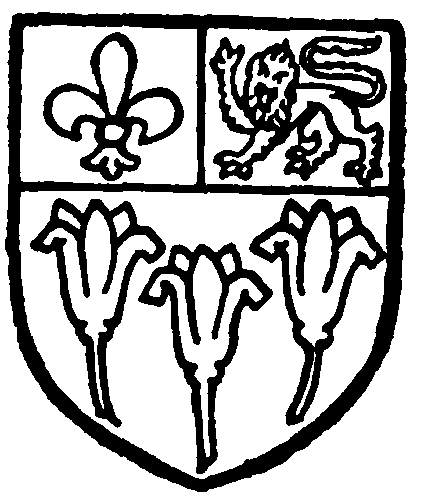
Eton College. Sable three lilies argent and a chief party azure and gules with a fleur de lis of France in the azure and a leopard of England in the gules.
After the Dissolution Henry VIII granted the manor of Bransbury to the Dean and Chapter of Winchester and their successors for a yearly rent, (fn. 72) and the estate was rented from the Dean and Chapter by John Ryves of Drayton in 1641 for the term of twenty-one years. (fn. 73) Bransbury was sold by the trustees under the Act for ' abolishing of Deans and Chapters' to Stephen Hurst and Richard Tutt in 1649, (fn. 74) but it seems to have been returned to the Dean and Chapter after the Restoration. (fn. 75)
At the present day (1910) Bransbury belongs to Mr. R. K. Hodgson and Mr. P. C. Tarbutt, but all manorial rights have long ceased. Mr. Hodgson's part, the larger, has come to him partly by inheritance, partly by purchase, Mr. Tarbutt's by purchase. (fn. 76)
DRAYTON (Droegtun, Draitone, xi cent.; Dreyton, xiv cent.) appears to have been granted by Edward the Elder (901–24) to the abbey of Hyde, (fn. 77) to which house Cnut restored it in 1019, after an unjust deprivation, (fn. 78) and it was among the lands held of the abbey by a freeman in the reign of the Confessor. (fn. 79) At the time of the Domesday Survey part of the manor was held by Hugh de Port, (fn. 80) while the remainder was retained by the abbey in demesne. (fn. 81) In the 13th century Hugh de Port's successors the St. Johns enfeofted the Braibœufs of their holding, (fn. 82) while the actual tenant under the Braibœufs in the reign of Henry III was Sir Herbert de Calne, who held also the rest of the manor at fee-farm from the Abbot of Hyde. (fn. 83) Sir Herbert's son and namesake succeeded to the estate before 1272, (fn. 84) in which year he granted his brother Baldwin, for the yearly rent of a clove gillyflower, one messuage with 2 carucates of land in Drayton, with reversion to himself and his heirs after the death of Baldwin. (fn. 85) Herbert died seised of the manor in 1294, (fn. 86) leaving a son Herbert, (fn. 87) who seems to have died a minor, and a daughter Marjory, who married Sir Roger Woodlock (fn. 88) and became her father's heiress. (fn. 89) After her death her possessions were for many years the subject of dispute between her kinsfolk. In 1316 Sir Roger Woodlock made a quitclaim of the Calne lands in Dorset from himself and his heirs to William des Roches, (fn. 90) the great-grandson of Euphemia daughter of Sir Herbert de Calne, (fn. 91) who seems in return to have recognized the right of the Woodlocks to Drayton, for Roger the son of Roger Woodlock (fn. 92) was seised of the manor in 1330. (fn. 93) In 1346, however, a suit was brought against him by Thomas de Dummer, a descendant of Sibyl, the sister of Sir Herbert de Calne, who disputed the legitimacy of Euphemia and declared that her descendants had no right to deal with the manor. (fn. 94) It is not known how the case was decided, but the succession to the estate was still in dispute in 1383, (fn. 95) in which year Joan the wife of John Penros declared that it was her right, and that she had been unjustly disseised of the manor by John Baker (Pyster). (fn. 96) John Baker was the grandson of Ursula Woodlock, who was probably a daughter of Roger and had married Ralph Baker, (fn. 97) but the ground on which Joan Penros claimed the manor is not stated; she was the daughter of Richard Carnver, (fn. 98) but whether she was of kin to the Woodlocks or had revived the claim of Thomas de Dummer is uncertain. Her suit was unsuccessful, and the Bakers remained in possession of the estate until 1446, in which year they sold it to Robert Ingpen. (fn. 99)
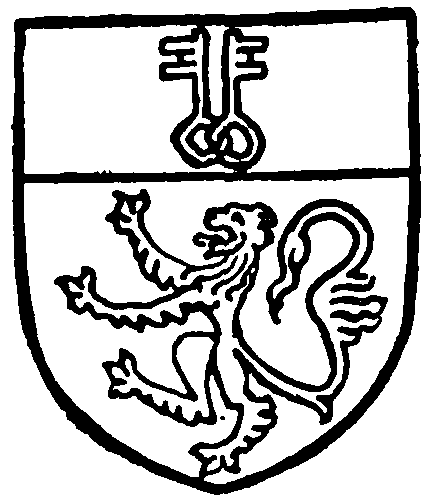
Hyde Abbey. Argent a lion sable and a chief sable with two keys argent set upright therein having their bows linked together.
The convent of Hyde continued to 'receive separately from the portion of the abbot thereof the rents from Drayton ' until 1448, (fn. 100) when they released all their right therein to Robert Ingpen and Alice his sister, (fn. 101) members of a family which had been established in the neighbourhood at least as early as 1336. (fn. 102) John Ingpen died seised of a holding in Drayton in 1510, (fn. 103) but the lord of the manor in the reign of Elizabeth was Sir Matthew Carew. He had married Alice the granddaughter of John Ingpen, (fn. 104) and in 1607 they sold the estate to Edmund Ryves. (fn. 105) In 1614 John Ryves died seised of the manor and was succeeded by his son Edmund, (fn. 106) who died in 1639, leaving the estate to his infant son and heir John. (fn. 107) In 1684 Drayton was sold to the owners of Cranborne in Wonston, (fn. 108) and it has since followed the same descent as that manor.
Church
The church of ALL SAINTS consists of a chancel 30 ft. 11 in. by 16 ft. 9 in., north transept 16 ft. 11 in. wide by 12 ft. deep, south transept 16 ft. 7 in. wide by 14 ft. 8 in. deep, nave 38 ft. 2 in. by 17 ft., north aisle 9 ft. 11 in. wide, south aisle 10 ft. 4 in. wide and west tower 10 ft. 9 in. by 12 ft. deep. All these measurements are internal.
The oldest work in the church is part of a nave of two bays which had narrow aisles, and a chancel of which no evidence remains; this was built late in the 12th century. About 1250 the building was enlarged almost to its present size, the nave being increased to three bays, and the chancel and transepts added as they now stand and the aisles widened. The aisles were remodelled, though probably not rebuilt, in the 15 th century, and near the end of the same century the tower was added. It was brought partly into the nave, breaking the westernmost bays of the arcades; doubtless because of the nearness of the west boundary of the churchyard. Since then no important alterations or additions have been made beyond the porch (built in 1862) and the usual restorations, &c. Much plain stone surface in the church has been retooled in modern times, causing it to lose almost all appearance of age.
The 13th-century scheme of enlargement eastward is very well planned, giving a great deal of floor space with the minimum of obstruction by the supports required. Similar cruciform enlargements are not uncommon at the date, Milford-on-Sea being a very fine example.
The east window of the chancel has old quoin-stones to the inner jambs and an old chamfered rear arch, but the rest, consisting of three plain lancet lights, is modern. On either side of the window are half octagonal brackets, both cut away below; the south one has a face carved on its chamfered front edge. In the south wall is a piscina with a filleted edge roll on its jambs and trefoiled head; at the springing are the grooves for a wooden shelf. The window in this wall has two lancet lights with a chamfered rear arch, and is all modern except the inner jambs and rear arch. The north wall is unpierced, but there are signs in the flintwork outside of the former existence of a window.
The church has north and south arcades of four bays, the western bay being broken into by the east wall of the tower.
One bay is in the chancel, the chancel arch and the western arches of the transepts springing from the first pillars, which are no larger than the others in spite of their extra burden and add to the general effect of lightness. The two eastern bays of the arcades are of 13th-century work and have slender octagonal pillars with bases of two rounds, and moulded bell capitals; the second pair of pillars, which take the place of the tormer east responds of the 12th-century nave, have plain chamfered abaci, and the capitals, except that of the second pillar of the south arcade, are enriched with nail-head or dog - tooth ornament. The arches are two centred and of two chamfered orders, they spring from an octagonal die rising above the capital, after a manner common in the latter part of the 13th century. The chancel arch is like the others, and the two west bays of the arcades are of 12th-century date, the pillars (the third on either side) being round and more substantial than the others. The bases are moulded with a round and ogee, and are obviously of later date. The capital in the north arcade is scalloped, and square in plan above, with a grooved and chamfered abacus, while that on the south is moulded. The arches, which are of a single chamfered order with grooved and chamfered labels on both faces, hardly find room on the abacus, suggesting that they are cut through an older wall, which is probably the case, and an aisleless nave must have existed before the late 12th-century enlargements. The western responds are buried in the later walling of the tower which encroaches on the arcades, but the face of the north respond and part of its arch are visible in the walling beyond the tower buttress in the north aisle, and the western angles of the nave show outside on the tower walls.
The north transept has a lancet window in its east wall with a modern head and some new stones in the jambs. In the south wall is a small plain piscina with a chamfered two-centred head, and in the north wall a window of two lancets with a quatrefoil over within a segmental inclosing arch; it has a chamfered rear arch and appears to be entirely original.
The arch between the transept and north aisle is similar in detail to the others, but its north jamb is chamfered only on the east side, the soffit being flush with the aisle wall; its capital is moulded and has a hollow-chamfered abacus.
The only window in the north wall of the north aisle is one of the 15th century, which has three cinquefoiled lights under a four-centred arch with a moulded outer label. West of the window is a blocked doorway of the same date, with chamfered jambs and four-centred arch; the west window of the aisle is a trefoiled single light with a four-centred head and label similar to that of the north window.
The south transept has two lancets in its east wall, although it is of little greater depth than the other; both are original but partly restored. The south window of the transept appears to be all modern; it has three lancet lights, the middle one taller than the others, with a moulded label outside; below it is a plain pointed piscina with a round basin. In the angle west of the window is the entrance to a roodstair turret, the three lowest steps of which, now shown, were discovered in 1901; the bottom step is 4 ft. 5 in. above the floor. The arch into the aisle corresponds with that opposite. The lancet window to the west of it, in the south wall, is all modern, and occupies the place of the doorway from the turret; west of it is a 15th-century window of three cinquefoiled lights under a four-centred head, which is interesting as having cut on its outer sill a 15th-century inscription: 'Hic jacet humatus Ihon Pann (or Paull) civellia natus.' The south doorway is of two chamfered orders, with a two-centred drop arch; it is all modernized except a part of the arch, which is of 15th-century date, and has to the east, inside the church, a holy water recess. Over the doorway are set two carved stones. The third south window is of three lights resembling the second; and the west window is one of the same date with two lights.
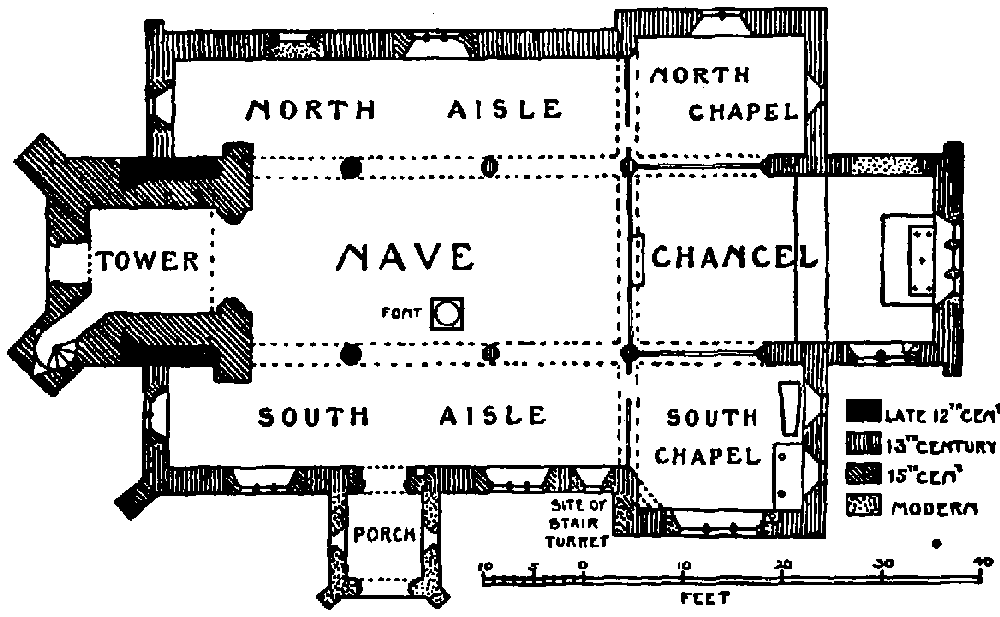
Plan of Barton Stacey Church
The tower is built of ashlar in three stages with diagonal buttresses at its western angles, and at the north-east and south-east smaller buttresses flush with the wall and stopping below the aisle roofs. The arch opening from the nave has semi-octagonal jambs and an arch of three chamfered orders dying on the jambs. The west wall is pierced by a doorway and a window, the former with double hollow-chamfered jambs and four-centred arch under a square head with a plain cut label; the window has three lights with plain four-centred heads under a square plain cut label.
The stair turret is set diagonally at the south-west angle. The second stage has rectangular lights on the west and south, and the third, or bell-chamber stage, has three-light windows like that on the lowest stage. The parapet is embattled, and has grotesques projecting from its moulded string-course; at the angles are crocketed pinnacles, probably later restorations. The stair turret rises in octagonal form above the parapet.
The walling of the church is of the local flint with stone dressings, and the roofs are covered with tiles. The chancel roof is modern, open timbered below, with half-round trusses to each rafter; the nave has a half-round plastered ceiling, and both transepts have ceilings plastered below the collar-beam trusses; the north aisle roof is half gabled, and the south aisle has a flat lean-to roof.
The altar table is of the 17th century, and has its front legs carved with figures of Faith, Hope and Charity.
The other furniture is all modern except the font, which is contemporary with the late 12th-century church; it has a square bowl of Purbeck marble, the sloping sides being relieved with shallow round-headed panels. The basin is circular and lines have been cut in the spandrels of the top; it is supported on a round stem and four round shafts with moulded bases standing on a modern chamfered plinth. The cover is a flat one of nine small quatrefoiled panels made up in 1870 from a screen formerly in Longparish Church.
There are no old monuments beyond some 17th-century gravestones and later mural wall tablets, &c.
There are five bells, all but the second by Cor of Aldbourne, 1725; the second is by T. Mears, 1828. On the third bell is 'c. winkwoth gave five guineas, 1725,' and on the fourth, 'martin wright esquier gave ten guineas, 1725.'
The plate consists of a silver chalice and paten cover of 1569, an undated paten, a flagon of early 19th-century workmanship given by Mr. J. W. B. Birch, of Cavendish Square, W., tenant of Drayton Park from May 1868 to October 1880, and a plated paten and two glass cruets. There are also a pewter flagon and two pewter plates.
The registers are in two books, the first containing baptisms and burials from 1713 to 1812, and marriages from 1713 to 1750; the second containing marriages from 1761 to 1812.
Advowson
The church of Barton Stacey stood upon the land held by Walter son of Roger de Pistes in 1086 (fn. 109) and afterwards by his son Miles Earl of Gloucester, who gave it, circa 1136, to the abbey of Lanthony, co. Gloucester. (fn. 110) A question as to the right of presentation which arose between the king and the Prior of Lanthony in 1260 (fn. 111) was decided in favour of the latter, and licence to appropriate the church was afterwards granted to the priory. (fn. 112) After the Dissolution the advowson was granted in 1541 to the Dean and Chapter of Winchester, (fn. 113) the present patrons. Dependent on the church of Barton Stacey was the chapel of Newton Stacey, which was appropriated to the priory of Lanthony with the mother church. (fn. 114) It seems to have been destroyed about 1635, for in that year Sir Robert Payne complained that some of the parishioners had demolished the chapel at Newton Stacey and maliciously opposed his intent to restore at his own charge the church of Barton Stacey which he had found ruinous. (fn. 115)
A Primitive Methodist chapel was built in Barton Stacey in 1844.
Charities
In 1774 Jacob Hinxman by will devised a field in the parish, containing 1a. 1r. 21p., now let at £3 a year, for the distribution of bread. In 1907 52 gallons of bread were given to sixty-six persons.
In 1784 Dorothy Wright and Elizabeth Wright (sisters) by deed (enrolled) gave £700 stock upon trust that the income should be applied for the education of twelve poor children, and subject thereto for the poor. The trust fund now consists of £700 consols, producing yearly £17 10s., of which the sum of £12 10s. is paid to the Education Committee of the Hants County Council and £5 to the managers of the Barton Stacey School.
In 1791 the same Elizabeth Wright by deed (enrolled) gave a further sum of £700 stock upon trust that the income should be distributed every St. Thomas's Day among poor inhabitants not in receipt of parish relief. The trust fund now consists of £700 consols producing yearly £17 10s. In 1907 sixty-six persons received gifts of money.
In 1905 Mrs. Martha Sharrow, by will proved 29 July, bequeathed to the vicar and churchwardens £100 upon trust to invest the same and apply the income—subject to the repair of grave—to some deserving old man or woman resident in the parish. The legacy was invested in £115 2s. 1d. consols, producing yearly £2 17s. 4d.
The several sums of stock are held by the official trustees.


